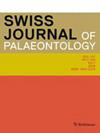德国伯恩堡 Buntsandstein(中三叠世)Trachelosaurus fischeri 的重新描述:欧洲第一只类似恐龙的海洋爬行动物及其对长颈早期古龙类的系统影响
IF 2.2
2区 地球科学
Q1 PALEONTOLOGY
引用次数: 0
摘要
古龙类(即非古龙形态的古龙类)的一些最早成员具有极长的颈部。最近在中国南方关岭地层(中三叠世)发现的化石显示,这些极长颈的弓形龙类的已知非形态多样性急剧增加,其中包括完全生活在海洋中的东方恐龙。最近的这些发现值得我们重新研究历史收藏中来自同时代欧洲矿床的神秘的三叠纪双脊龙化石。在这里,我们对 Trachelosaurus fischeri 进行了重新描述,其代表化石是 1918 年首次描述的一个单独的解体标本。由于其独特的形态,包括短的、分叉的颈肋和较多的椎骨,该类群一直被称为 "原龙类 "古龙形目或长棘龙类。我们的修订清楚地表明,驯龙是关岭地层以外已知的第一个明确的类恐龙弓龙。我们的发现具有重要的系统学意义。Trachelosauridae Abel, 1919 是最近发现的恐龙头龙科 Spiekman, Fraser 和 Scheyer, 2021 的高级异名。基于我们的系统发育分析(采用了两个广泛的数据集),我们也证实了之前的发现,即栉龙科和三角龙科是非鳄龙类中一个更大的单系群中的两个科,在此命名为栉龙科(新支系)。栉龙科(Trachelosauridae)由栉龙(Trachelosaurus fischeri)、东方棘龙(Dinocephalosaurus orientalis)、振龙(Pectodens zhenyuensis)和小栉龙(Austronaga minuta)组成,但我们的一项分析还发现了一个可能在分类学上更为宽泛的支系,该支系可能还包括栉龙(Gracilicollum latens)和福源龙(Fuyuansaurus acutirostris)。栉龙(Trachelosaurus fischeri)大大扩展了栉龙科的已知时空范围,将其扩展到了最早的安息年和中欧盆地。我们的发现增加了越来越多的证据,证明在中三叠世湍龙科中存在着一个多样化的完全海洋性的爬行类群。这些栉龙类拥有鳍状肢、高椎骨数和长颈,因此在某些方面与侏罗纪和白垩纪的长颈长颈龙非常相似。本文章由计算机程序翻译,如有差异,请以英文原文为准。
A redescription of Trachelosaurus fischeri from the Buntsandstein (Middle Triassic) of Bernburg, Germany: the first European Dinocephalosaurus-like marine reptile and its systematic implications for long-necked early archosauromorphs
Some of the earliest members of the archosaur-lineage (i.e., non-archosauriform archosauromorphs) are characterised by an extremely elongated neck. Recent fossil discoveries from the Guanling Formation (Middle Triassic) of southern China have revealed a dramatic increase in the known ecomorphological diversity of these extremely long-necked archosauromorphs, including the fully marine and viviparous Dinocephalosaurus orientalis. These recent discoveries merit a reinvestigation of enigmatic Triassic diapsid fossils from contemporaneous European deposits housed in historical collections. Here, we provide a redescription of Trachelosaurus fischeri, represented by a single, disarticulated specimen first described in 1918. Due to its unique morphology, which includes short, bifurcating cervical ribs, and a high presacral vertebral count, this taxon has been referred to either as a “protorosaurian” archosauromorph or a sauropterygian. Our revision clearly shows that Trachelosaurus represents the first unambiguous Dinocephalosaurus-like archosauromorph known from outside the Guanling Formation. Our finding has important systematic implications. Trachelosauridae Abel, 1919 represents the senior synonym for the recently identified Dinocephalosauridae Spiekman, Fraser and Scheyer, 2021. Based on our phylogenetic analyses, which employ two extensive datasets, we also corroborate previous findings that tanystropheids and trachelosaurids represent two families within a larger monophyletic group among non-crocopodan archosauromorphs, which is here named Tanysauria (clade nov.). Trachelosauridae is minimally composed of Trachelosaurus fischeri, Dinocephalosaurus orientalis, Pectodens zhenyuensis, and Austronaga minuta, but one of our analyses also found a probably taxonomically broader clade that may also include Gracilicollum latens and Fuyuansaurus acutirostris. Trachelosaurus fischeri considerably expands the known spatial and temporal range of Trachelosauridae to the earliest Anisian and the Central European Basin. Our findings add to the growing evidence for the presence of a diverse group of fully marine reptiles during the Middle Triassic among Tanysauria. These trachelosaurids possess flipper-like limbs, high vertebral counts, and elongate necks, thus superficially resembling long-necked Jurassic and Cretaceous plesiosaurs in some regards.
求助全文
通过发布文献求助,成功后即可免费获取论文全文。
去求助
来源期刊

Swiss Journal of Palaeontology
Earth and Planetary Sciences-Paleontology
CiteScore
4.30
自引率
16.70%
发文量
17
审稿时长
4 weeks
期刊介绍:
The Swiss Journal of Palaeontology publishes original research and review articles of interest to the international community in the fields of palaeontology, taxonomy and systematics, while recognising at the same time the importance of documenting high-quality palaeontological data in a regional context. Palaeobiology in combination with alpha taxonomy is a core topic of the journal.
Submitted papers should have an appeal as wide as possible, directed towards an international readership. Contributions should not have been simultaneously submitted elsewhere, and the overlap of content between related articles should be minimal. Duplications of text and the use of previously published illustrations without adequate citation are unacceptable. If a manuscript has two or more authors, both or all have to sign to confirm they all were involved in the work and have agreed to its submission. The preferred manuscript language is UK English, but consistently used US English is also acceptable. We encourage the publication of proceedings of international meetings as well as special thematic issues. Short contributions and book reviews are also accepted.
An international editorial team as well as guest editors guarantee that the thematic issues as well as all articles in regular issues are peer-reviewed and meet the highest standards.
 求助内容:
求助内容: 应助结果提醒方式:
应助结果提醒方式:


